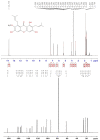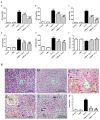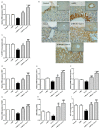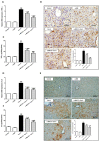Alpha-Mangostin as a New Therapeutic Candidate for Concanavalin A-Induced Autoimmune Hepatitis: Impact on the SIRT1/Nrf2 and NF-κB Crosstalk
- PMID: 36145841
- PMCID: PMC9502360
- DOI: 10.3390/plants11182441
Alpha-Mangostin as a New Therapeutic Candidate for Concanavalin A-Induced Autoimmune Hepatitis: Impact on the SIRT1/Nrf2 and NF-κB Crosstalk
Abstract
Alpha-mangostin (α-MN) is a xanthone obtained from Garcinia mangostana that has diverse anti-oxidative and anti-inflammatory potentials. However, its pharmacological activity against autoimmune hepatitis (AIH) has not been investigated before. Concanavalin A (Con A) was injected into mice to induce AIH and two doses of α-MN were tested for their protective effects against Con A-induced AIH. The results demonstrated the potent hepatoprotective activity of α-MN evidenced by a remarkable decrease of serum indices of the hepatic injury and amendment of the histological lesions. α-MN significantly attenuated the level and immuno-expression of myeloperoxidase (MPO) indicating a decrease in the neutrophil infiltration into the liver. Additionally, the recruitment of the CD4+ T cell was suppressed in the α-MN pre-treated animals. α-MN showed a potent ability to repress the Con A-induced oxidative stress evident by the reduced levels of malondialdehyde (MDA), 4-hydroxynonenal (4-HNE), and protein carbonyl (PC), as well as the enhanced levels of antioxidants as the reduced glutathione (GSH), superoxide dismutase (SOD), and total antioxidant capacity (TAC). The ELISA, RT-PCR, and IHC analyses revealed that α-MN enhanced the sirtuin1/nuclear factor erythroid 2 related factor-2 (SIRT1/Nrf2) signaling and its downstream cascade genes concurrently with the inhibition of the nuclear factor kappa B (NF-κB) and the inflammatory cytokines (tumor necrosis factor-alpha and interleukine-6) signaling. Taken together, these results inferred that the hepatoprotective activity of α-MN could prevent Con A-induced AIH through the modulation of the SIRT1/Nrf2/NF-κB signaling. Hence, α-MN may be considered as a promising candidate for AIH therapy.
Keywords: Garcinia mangostana; SIRT1/Nrf2/NF-κB signaling; autoimmune hepatitis; concanavalin A; xanthones; α-mangostin.
Conflict of interest statement
The authors declare no conflict of interest.
Figures









Similar articles
-
Garcinone E Mitigates Oxidative Inflammatory Response and Protects against Experimental Autoimmune Hepatitis via Modulation of Nrf2/HO-1, NF-κB and TNF-α/JNK Axis.Nutrients. 2022 Dec 21;15(1):16. doi: 10.3390/nu15010016. Nutrients. 2022. PMID: 36615674 Free PMC article.
-
γ-Mangostin abrogates AINT-induced cholestatic liver injury: Impact on Nrf2/NF-κB/NLRP3/Caspase-1/IL-1β/GSDMD signalling.Life Sci. 2023 Jun 1;322:121663. doi: 10.1016/j.lfs.2023.121663. Epub 2023 Apr 5. Life Sci. 2023. PMID: 37023956
-
Cucurbitacin E glucoside alleviates concanavalin A-induced hepatitis through enhancing SIRT1/Nrf2/HO-1 and inhibiting NF-ĸB/NLRP3 signaling pathways.J Ethnopharmacol. 2022 Jun 28;292:115223. doi: 10.1016/j.jep.2022.115223. Epub 2022 Mar 27. J Ethnopharmacol. 2022. PMID: 35354089
-
Anti-fibrotic activity of sitagliptin against concanavalin A-induced hepatic fibrosis. Role of Nrf2 activation/NF-κB inhibition.Int Immunopharmacol. 2021 Nov;100:108088. doi: 10.1016/j.intimp.2021.108088. Epub 2021 Aug 25. Int Immunopharmacol. 2021. PMID: 34454288
-
Pristimerin as a Novel Hepatoprotective Agent Against Experimental Autoimmune Hepatitis.Front Pharmacol. 2018 Mar 28;9:292. doi: 10.3389/fphar.2018.00292. eCollection 2018. Front Pharmacol. 2018. PMID: 29643811 Free PMC article.
Cited by
-
Garcinone E Mitigates Oxidative Inflammatory Response and Protects against Experimental Autoimmune Hepatitis via Modulation of Nrf2/HO-1, NF-κB and TNF-α/JNK Axis.Nutrients. 2022 Dec 21;15(1):16. doi: 10.3390/nu15010016. Nutrients. 2022. PMID: 36615674 Free PMC article.
-
SIRT1/Nrf2/NF-κB Signaling Mediates Anti-Inflammatory and Anti-Apoptotic Activities of Oleanolic Acid in a Mouse Model of Acute Hepatorenal Damage.Medicina (Kaunas). 2023 Jul 24;59(7):1351. doi: 10.3390/medicina59071351. Medicina (Kaunas). 2023. PMID: 37512162 Free PMC article.
-
Health position paper and redox perspectives - Bench to bedside transition for pharmacological regulation of NRF2 in noncommunicable diseases.Redox Biol. 2025 Apr;81:103569. doi: 10.1016/j.redox.2025.103569. Epub 2025 Mar 3. Redox Biol. 2025. PMID: 40059038 Free PMC article. Review.
-
α-Mangostin Is a Xanthone Derivative from Mangosteen with Potent Immunomodulatory and Anti-Inflammatory Properties.Biomolecules. 2025 May 7;15(5):681. doi: 10.3390/biom15050681. Biomolecules. 2025. PMID: 40427574 Free PMC article. Review.
References
-
- Tang H.H., Li H.L., Li Y.X., You Y., Guan Y.Y., Zhang S.L., Liu L.X., Bao W.L., Zhou Y., Shen X.Y. Protective effects of a traditional Chinese herbal formula Jiang-Xian HuGan on Concanavalin A-induced mouse hepatitis via NF-kappaB and Nrf2 signaling pathways. J. Ethnopharmacol. 2018;217:118–125. doi: 10.1016/j.jep.2018.02.003. - DOI - PubMed
Grants and funding
LinkOut - more resources
Full Text Sources
Research Materials
Miscellaneous

